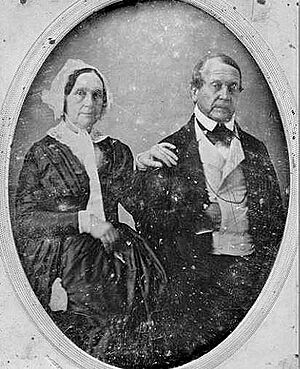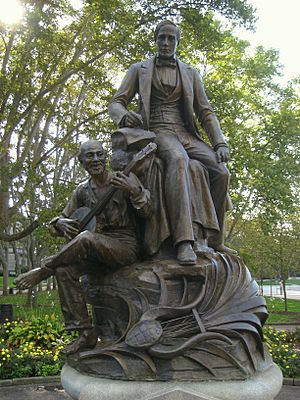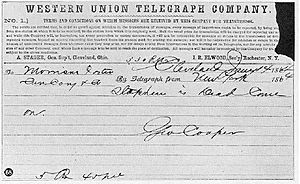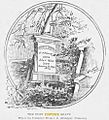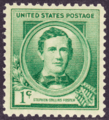Stephen Foster facts for kids
Quick facts for kids
Stephen Foster
|
|
|---|---|
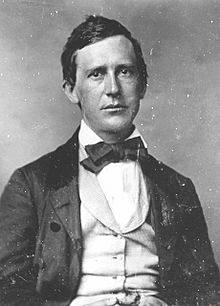
Stephen Collins Foster
|
|
| Born |
Stephen Collins Foster
July 4, 1826 Lawrenceville, Pennsylvania, U.S.
|
| Died | January 13, 1864 (aged 37) New York City, New York, U.S.
|
| Resting place | Allegheny Cemetery |
| Nationality | American |
| Occupation | Songwriter |
| Spouse(s) | Jane Denny MacDowell |
| Children | Marion (daughter) |
| Parent(s) | William Barclay Foster Elisa Clayland [Tomlinson] Foster |
Stephen Collins Foster (born July 4, 1826 – died January 13, 1864) was an important American songwriter. He was one of the first composers in the United States to earn money from his songs. Publishers paid him so they could print and sell his music.
Stephen Foster was born in Lawrenceville, Pennsylvania. This area is now part of Pittsburgh. His family was wealthier than many others in the city. His most famous song is "Oh! Susanna". It was first played in Pittsburgh in 1847.
In July 1850, Foster married Jane Denny MacDowell. They had one daughter named Marion. Their marriage had problems, and they later separated. Stephen Foster moved to New York City to focus on writing songs. He died there on January 13, 1864, when he was 37 years old.
Foster wrote songs in three main styles. These included plantation songs like "Oh! Susanna" and "Camptown Races". He also wrote parlor songs such as "Jeannie with the Light Brown Hair" and "Beautiful Dreamer". Some of his songs were about the Civil War, like "We Are Coming, Father Abraham".
Contents
Stephen Foster's Early Life
Stephen Collins Foster was born on July 4, 1826. His parents were William Barclay Foster and Elisa Clayland [Tomlinson] Foster. Stephen was born at his father's home, called "The White Cottage." This home was in Lawrenceville, Pennsylvania, near Pittsburgh.
He was the youngest of his parents' children. His parents, William and Elisa, got married on November 14, 1807. They were married in Chambersburg, Pennsylvania.
William Barclay Foster was a leader in western Pennsylvania. He had settled near Pittsburgh. The Fosters had several children before Stephen. These included Charlotte, Ann, Henry, Henrietta, Dunning, and Morrison. Another son was born in 1829 but died young.
The Foster family lived in a beautiful cottage. It was high on a hillside above the Allegheny River. This area was a suburb of Pittsburgh called Lawrenceville. Stephen's father, William, had helped plan and develop this town.
Boyhood and Youthful Interests
Stephen was five years old when he started school. In 1833, he went to the Alleghany Academy. This school was for children from important families. It was started by a Presbyterian minister named Rev. Joseph Stockton.
In 1834, Stephen went to a black church with a servant named Olivia Pise. In 1836, his family moved to Allegheny City. This happened when Stephen's father became the Collector of the Pennsylvania Canal.
Stories from his family say that Stephen could pick out music on a guitar at age two. They also say he played a flageolet perfectly at age seven. When he was nine, he sang and performed in plays with other boys in his neighborhood.
Songs for the Stage
Stephen Foster wrote 28 songs for the minstrel stage. Minstrel shows were popular entertainment at the time.
A typical minstrel song by Foster had a solo singer. It also had a chorus of four or five parts for the main part of the song. There was often a short music section for dancing on stage. Some of his best minstrel songs include "Oh! Susanna" (1848) and "Nelly Bly" (1849). Others are "Camptown Races" (1850), "Massa's in de Cold Ground" (1852), "Old Folks at Home" (1860), and "Old Black Joe" (1860).
Family Life
Stephen Foster married Jane Denny McDowell on July 22, 1850. They were married in Trinity Episcopal Church in Pittsburgh. Jane was the daughter of a doctor from Pittsburgh, Andrew N. McDowell.
Stephen and Jane had one child, a daughter named Marion. Marion was born on April 18, 1850.
Marion Foster's Life
Marion Foster (1850 - 1935) grew up and married William Welsh. They had three children. Marion lived in St. Louis and Chicago for a while. In 1914, she moved back to Lawrenceville. She lived in a large house as a caretaker. This house was on the same land where her grandparents' home used to be.
Marion was not wealthy. She gave piano lessons even when she was in her seventies. She also tried to get back some land that once belonged to her grandfather. However, she was not successful.
Stephen Foster's Death
On Saturday, January 9, 1864, Stephen Foster felt unwell. He went to bed early. He was staying in a simple hotel in New York City. On Sunday morning, he spoke to a maid at his door. Then he fell, hurting his neck.
A doctor came and treated his injury. Foster was then taken to Bellevue Hospital. This was a hospital for people who could not afford to pay much. He was listed as a "laborer" in the hospital records. He was uncomfortable and did not like the food there. On January 13, he was eating soup when he passed away.
His funeral was held in Trinity Episcopal Church in Pittsburgh. This was on January 21. When his coffin arrived at the Allegheny Cemetery, a band played his songs. He was buried near his mother and father.
Most newspapers did not report his death. Many songs were released after he died and were said to be his last. "The Voices That are Gone" (published in 1865) and "Kiss Me Mother Ere I Die" (1869) are likely his final works.
Honors and Memorials
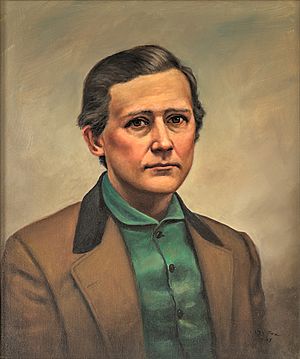
Stephen Foster is honored at the University of Pittsburgh. There is a special building called the Stephen Foster Memorial. This building has the Stephen Foster Memorial Museum. It also has the Center for American Music. Two theaters, the Charity Randall Theatre and Henry Heymann Theatre, are also there. These are used for performances by the university's theater department.
The memorial is the largest place to find Stephen Foster's original songs. It also has recordings and other items inspired by his music from all over the world.
Two state parks are named after Stephen Foster. One is the Stephen Foster Folk Culture Center State Park in White Springs, Florida. The other is Stephen C. Foster State Park in Georgia. Both of these parks are located on the Suwannee River. Stephen Foster Lake in Mt. Pisgah State Park in Pennsylvania is also named after him.
One state park is named after one of his famous songs. This is My Old Kentucky Home State Park. It is a historic mansion in Bardstown, Kentucky. Stephen Foster's brother, Morrison Foster, said Stephen sometimes visited this home. The park has a bronze statue to honor Stephen's work.
The Lawrenceville (Pittsburgh) Historical Society and the Allegheny Cemetery Historical Association host an event each year. It is called the Stephen Foster Music and Heritage Festival (Doo Dah Days!). It happens on the first weekend of July. Doo Dah Days! celebrates the life and music of this important American songwriter. His childhood home in Lawrenceville, Pittsburgh, is still on Penn Avenue. It is near the Stephen Foster Community Center.
Images for kids
-
House in Hoboken, New Jersey where Foster is believed to have written "Jeanie with the Light Brown Hair" in 1854
-
Pitt's Stephen Foster Memorial contains two theaters
See also
 In Spanish: Stephen Foster para niños
In Spanish: Stephen Foster para niños


